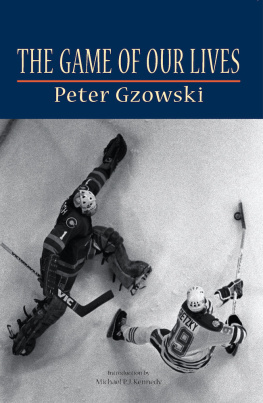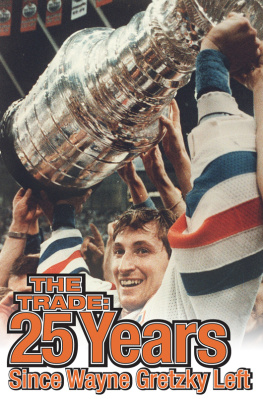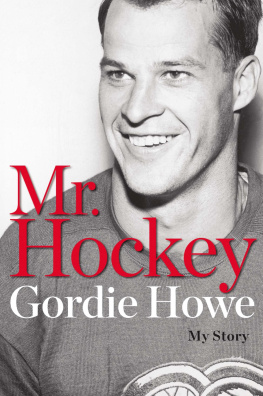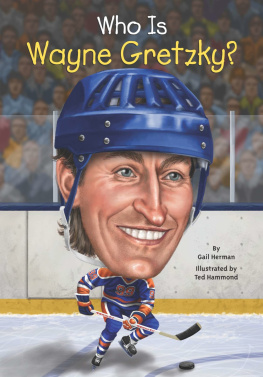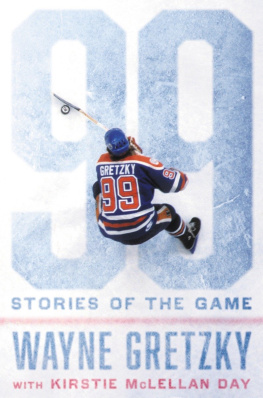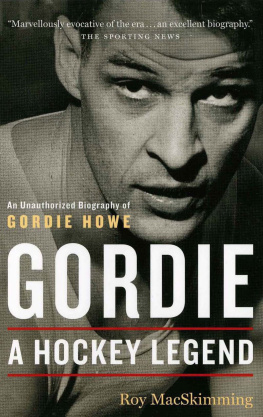Their hands were a better sign of their profession than their faces
Of all the young mercenaries who began the 198081 National Hockey League season with the Edmonton Oilers, only one, Mark Messier, had grown up in Edmonton. Messier was still a teenager that fall, although he had a body sculptors would kill for. On the ice, he played with what he liked to call reckless abandon, probably unaware that the phrase echoed back to players as ancient as Sprague Cleghorn, a face-breaking defenceman of the 1920s. Messier sometimes played with reckless abandon off the ice, too. He had a wide-eyed look when he was excited, and his nostrils seemed to flare. In the dressing room he would occasionally break into song. With his head thrown back, his eyes closed, his Praxitelean body naked, one hand cupped over his genitals, he would bellow, been down so long it looks like up to me. Messiers father was a schoolteacher who also coached hockey; sometimes Mark would stay at his parents house in Edmonton and sometimes he would not.
Messier and Don Murdoch, a right-winger from Cranbrook, British Columbia, with a troubled past, were related on their mothers side and had known each other casually when they were growing up. But the rest of the Oilers had met only when they came to Edmonton to play hockey. They had come from as nearby as Ponoka, Alberta, and as far away as Mantta, Finland. More of them, nine, came from Ontario than anywhere else. Although two of them had been born in Toronto, one in Winnipeg, and one in Chicago, the names of many of their birthplaces sounded like the timetable of an old-fashioned Canadian train, running from Charlottetown in the east to Nelson in the west, and passing on the way through such communities as Hawkesbury, Petrolia, Birtle, and Cold Lake.
They lived in various accommodations around Edmonton. A few of them were married and owned their own houses. Blair MacDonald, their handsome captain, spent much of the summer of 1980 working on a spacious old house he and his wife had bought across from the Provincial Museum, sanding the floors and tearing down a wall between the kitchen and what was to be a dining area. Lee Fogolin, a defenceman with wrists the size of some mens thighs, liked to stay at his suburban home and work with wood. The cabinet in which the team stored videotapes of its games was a product of Fogolins home workshop. One or two of the bachelor crowd shared their quarters with permanent lady friends. Paul Coffey, a rookie, maintained a room at the Edmonton Plaza Hotel, partly out of shyness and partly because he was still not sure he would not be assigned to the minor leagues. But by far the most common arrangement was to live with other members of the team, in apartments or condominiums or houses. Housing was not cheap in Edmonton, a city enjoying the profits of the Alberta oil boom, but the Oilers lived high in the middle class. Bryan Watson, their coach, once drew up a map to see who lived close to which shopping centre, to facilitate personal appearances through the season. The map looked like a guide to the more affluent neighbourhoods of Edmonton, with clusters near the University of Alberta, in the prosperous west end, and around the Whitemud Freeway on the way to the airport.
Gathering for a road trip, the Oilers would often descend on the airport in groups. In concession to Edmontons northern climate and rude setting, some of them drove Jeeps or panel trucks. Others settled for standard American cars. Cars were an important part of their lives, but those who owned exotic breedsWayne Gretzky, their young superstar, had a $57,000 black Ferrariwould leave them elsewhere; getting to the airport called for practical transportation. At the airport, the discrepancies in their lifestyles would disappear; they became an entity. They dressed similarly, in slacks and well-tailored sports jackets, or well-cut suits. Their clothes showed their slim hips. Their shoes or cowboy boots were always shined. Even those who wore their hair long never needed it cut. Three of their veterans wore neatly trimmed beards; and as the season began, some of the younger players were trying to grow beards, too, but even unshaven they looked kempt, like studiously casual fashion models. All of them could have been described as handsome, though in different ways. Their colouring varied from the pale blond of the Finnish defenceman Risto Siltanen to the swarthiness of the shy rookie Coffey, and their height from Siltanens five-eight to the looming six-four of their square-jawed enforcer, Dave Semenko. Their faces were sometimes emblazoned with cuts or scrapes or bruises, but in the age of helmetsonly four of them played withoutthey were usually unmarked. One or two had complexion problems. Their hands were a better sign of their profession than their faces; nearly all of them had large hands.
Even their baggage was alike. They packed what they needed for a weeks road trip into a carry-on valise, with an extra jacket pressed into a hanging bag, which they would stow in the aircraft locker, or hand to a stewardess to store at the back. They called stewardesses miss or maam. Their seats were assigned by Rod Phillips, the bespectacled play-by-play radio announcer who also acted as the teams travelling secretary. Few of them would read, and those who did concentrated on thrillers or science fiction. If there was a new edition of the weekly Hockey News, they passed that around, and they shared the sports section of the paper from whatever city they had just left. The front section of the newspaper meant little to them, and the magazines that attracted their attention almost all contained pictures of naked women, which they chortled over. Their favourite movies were comedies; their favourite music channels, rock and roll. A few of them would play cards or backgammon for small stakes, but with extraordinary quickness; they were all good at games. Often, they would doze. They could fall asleep easily, their heads lolling against the seats, their ties now loosened. But they would not be still for long. They were healthy young men, in prime fettle, and even in the sedentary confines of an aircraft they needed to move around. They expressed themselves physically, wrestling, tugging, patting, slugging each other on the arm. For no apparent reason, one of them would suddenly wrap anothers neck in the crook of his arm and knuckle his hair. If anyone slept too long or too soundly, he ran the risk of waking up with his tie cut, or his cowboy boots filled with shaving cream.
The sense of pack that characterized them in airplanes was not confined to the road. The team was the nucleus of their lives. The rest of the world that spun around ittrainers, coaches, agents, writers, and, at the very outside, fanswas extrinsic. Even their families sometimes seemed less important to them than their playmates. After a trip of several days, during which they had travelled, eaten, dressed, drunk, played hockey, and roomed with one another, they were liable on their return to forsake their women and children and congregate in one of the Edmonton watering holes they favoured. Friendships were between the player and the team as a whole, rather than between individuals. For all their unity, no one wanted to become too close to anyone else, since a friend could be traded away without notice. As a result, the Oilers were virtually without cliques. On the road, roommates were rotated by management; recreationally oriented players were usually paired with the more dependable. After training camp, where veterans stayed aloof from rookies until it was clear who might belong on the team and who would go to the minors, social combinations would form and reform, so that the appearance of one Oiler at a particular bar or restaurant was no guarantee of the possible appearance of any other. The exception to this rule was the trio of Finns, Matti Hagman, Jari Kurri, and the squat defenceman Siltanen. The Finns formed a sort of club within the club, set apart by their inaccessible language. At training camp one morning, the coaches asked Hagman to count off the days warm-up exercises in Finnish:

